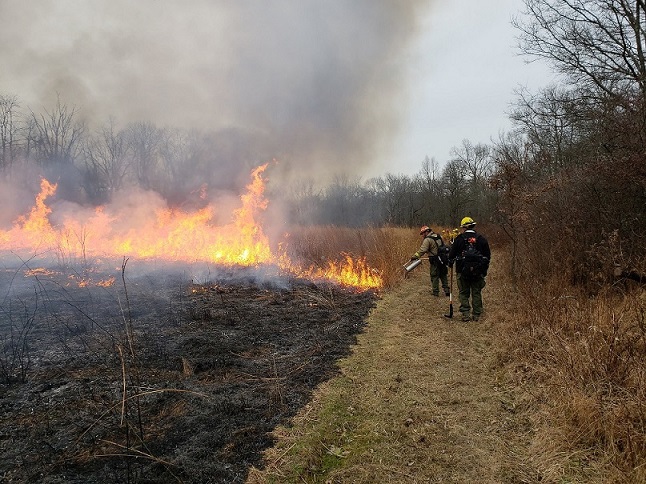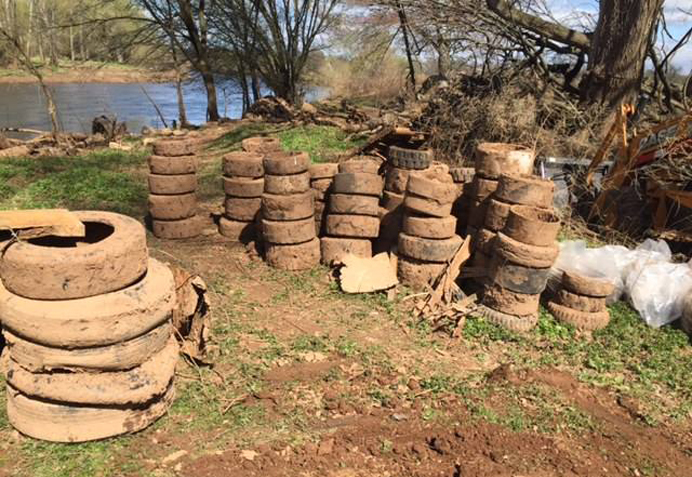Restoration Project Highlights

Prescribed Burns
Prescribed, or controlled, burns are conducted annually at the Environmental Education Center(EEC) and Washington Valley Park. Staff work closely with professionals from the NJ Forest Fire Service to follow an approved burn plan which retards invasive woody growth and invasive herbaceous species in both meadow and forest habitats. The burns encourage native grass and wildflower growth and return necessary nutrients back to the soil.
Prescribed burns are only feasible when atmospheric conditions are within prescription parameters; ideal temperature, relative humidity, and number of days prior with minimal precipitation. Prevailing winds are also closely monitored to ensure smoke produced will not raise public concerns or spread the fire.
The burns are typically conducted between October and April to help reduce the amount of fuel in the understory, thus limiting the risk of a future wildfire from occurring. The intense heat of the fire helps reduce the amount of invasive plant material present which allows native plants to regain a stronghold in our meadows and grasslands. Additionally, controlled burns serve as a vital means of recycling nutrients to the soil and encouraging vibrant spring growth.
Controlled burning is by no means a new premise. Intentional burns have been employed by indigenous people for centuries as a means of selectively choosing one form of ecosystem over another. Today controlled burns are an effective method used to prevent meadows and grasslands from undergoing succession and transitioning into young forests. Utilizing prescribed burns as a vital conservation tool ensures specific habitats are preserved for wildlife.
Prescribed burns can effectively reduce uncontrolled forest fires, recycle essential nutrients back into the soil, and help combat invasive plants. In a healthy ecosystem there is no waste. By mirroring the effects of naturally occurring fires we are able to maintain a well balanced ecosystem for many generations to come.
Watch a time lapse video of a prescribed burn in Alexander’s Meadow.
Pond Restoration
On behalf of the Environmental Education Center, The Somerset County Park Foundation received a grant from the U.S. Department of Agriculture Natural Resource Conservation Service (NRCS) to work together to restore Lily Pad Pond in Lord Stirling Park. Lily Pad Pond is a naturally occurring pond used year-round by participants and park Naturalists for pond study programs. The diversity of species found in Lily Pad Pond provides a phenomenal educational experience as well as a healthy and well-balanced ecosystem. Over time the natural process of succession has threatened the pond habitat as both native and invasive plant species encroach along the perimeter of the pond. Ignoring the growth has resulted in the pond getting smaller and shallower, to the point where the water has dried up entirely in the hot summer months. In order to preserve the pond as an educational resource, it is necessary for humans to manage the habitat. Park staff are working closely with NRCS staff to develop and execute a minimally invasive plan to maintain the aquatic habitat for future generations.

Protecting the Raritan River
The Somerset County Park Commission works closely with the Raritan Headwaters Association to promote an educational initiative to protect the Raritan River from invasive species and focus on spreading awareness about nuisance algae and the importance of leaving no trace of visits to the streams and rivers enjoyed by fisherman, kayakers, and boaters. The Park Rangers will serve as a positive presence at parks to educate visitors on the importance of taking personal responsibility for keeping the Raritan River healthy, clean, and safe.
Raritan River Clean Up Project
The continuation of an initiative that began in 2013 as "Just 2 Eagle Scouts" cleaning up sections of the Raritan River is now a full blown charitable venture focused on preservation of the environment in and around New Jersey's longest river.
"Just 2 Eagle Scouts," led the "South Branch/Raritan River Cleanup," a grassroots effort to clean a 10-mile stretch of the Raritan River from Neshanic Station to Raritan Borough. The effort resulted in removal of 507 tires and various other unwanted materials from the river over two weekends.
On May 12, 2014 approximately 900 tires were removed. The initiative is focused on removing tires from two dump locations in and along the bank of the Raritan River behind the Torpey Athletic Complex in Bridgewater. The removal team includes Somerset County Park Commission Maintenance staff, members of the Central Jersey Stream Team, and volunteers from Atlantic County Utilities Authority provided through NJ Clean Communities. The group’s efforts earned a Clean Water Award from NJ Clean Communities. Later, the Central Jersey Stream Team with the assistance of volunteers and Park Rangers removed four truck loads of trash and metal debris from the banks of the Raritan River behind Gerber Field near the Hillsborough and Manville border.
Annual river cleanups are done in Duke Island Park, Raritan River Greenway, and North Branch Park. It is expected that South Branch Greenway will be added during future efforts.The cleanups are generally done in partnership with local municipalities, corporate groups, scout groups, and other community groups.
Visit Central Jersey Stream Team for more information on local river cleanup projects.
